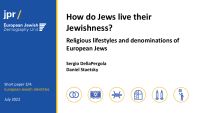How do Jews live their Jewishness? Religious lifestyles and denominations of European Jews
Author(s)
Publication Date
July 2022
Publication Place
Publisher
Abstract
The third of four mini-reports highlighting different aspects and findings from JPR’s major study ‘The Jewish identities of European Jews: what, why and how’, dives deeper into the different religious lifestyles and denominations of European Jews. Is there a single Jewish voice – or a majority Jewish voice – that represents the entire community? And if there is one – who holds it? In today’s political culture, understanding lifestyle differences within ethnic and religious groups is critical, both to understand their needs and concerns, and to address them.
The new mini-report highlights different aspects of how European Jews express their Jewishness through their choice of denomination – or lack of – and through different Jewish rituals:
• The most numerically significant subgroup is the ‘Just Jewish’ (38%), a general category indicating no clear denominational alignment, followed by the ‘Traditional’;
• European Jewry is undergoing a process of desecularisation: Today, across Europe, the share of more religious persons (Haredi and Orthodox) among younger age groups is substantially larger than among the older;
• The most traditional communities are those in Western Europe. In these communities, about 40%-60% of adult Jews identify as Traditional, Orthodox or Haredi;
• The less traditionally observant lifestyles are in the 74%-78% range in Denmark, Sweden and the Netherlands, and reach 90% in Hungary and Poland;
• Attending a Passover Seder and fasting on Yom Kippur are observed by most Jews, including those outside of the Haredi/Orthodox fold. Lighting candles on Friday night and keeping kosher at home are also observed by a much broader range of Jews than just those from the Haredi and Orthodox communities.
The report is based on research conducted in twelve European Union Member States in 2018, which, together, are home to about 80% of the Jewish population of Europe. The study includes the opinions and experiences of over 16,000 respondents – the largest sample of Jews ever surveyed in Europe.
The new mini-report highlights different aspects of how European Jews express their Jewishness through their choice of denomination – or lack of – and through different Jewish rituals:
• The most numerically significant subgroup is the ‘Just Jewish’ (38%), a general category indicating no clear denominational alignment, followed by the ‘Traditional’;
• European Jewry is undergoing a process of desecularisation: Today, across Europe, the share of more religious persons (Haredi and Orthodox) among younger age groups is substantially larger than among the older;
• The most traditional communities are those in Western Europe. In these communities, about 40%-60% of adult Jews identify as Traditional, Orthodox or Haredi;
• The less traditionally observant lifestyles are in the 74%-78% range in Denmark, Sweden and the Netherlands, and reach 90% in Hungary and Poland;
• Attending a Passover Seder and fasting on Yom Kippur are observed by most Jews, including those outside of the Haredi/Orthodox fold. Lighting candles on Friday night and keeping kosher at home are also observed by a much broader range of Jews than just those from the Haredi and Orthodox communities.
The report is based on research conducted in twelve European Union Member States in 2018, which, together, are home to about 80% of the Jewish population of Europe. The study includes the opinions and experiences of over 16,000 respondents – the largest sample of Jews ever surveyed in Europe.
Topics
Jewish Identity Main Topic: Identity and Community Religious Belief Religious Observance and Practice Religious Denominations Surveys Ritual
Genre
Geographic Coverage
Original Language
Series Title
Series Number
3
Link
Link to article including link to pdf, How do Jews live their Jewishness? Religious lifestyles and denominations of European Jews
Bibliographic Information
How do Jews live their Jewishness? Religious lifestyles and denominations of European Jews. . July 2022: https://archive.jpr.org.uk/object-2760




